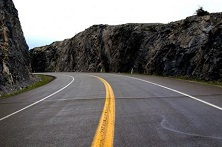|
page 10 of 11
Poor Driving Conditions
 Driving in the fog can be a very challenging task. You should be mentally alert and obtain maximum visibility using the following devices:
Headlamps
Fog lights and mounting
Windshield wipers and defrosters
Driving in the fog can be a very challenging task. You should be mentally alert and obtain maximum visibility using the following devices:
Headlamps
Fog lights and mounting
Windshield wipers and defrosters
As soon as you enter the fog area, do not stop your vehicle, but do reduce your speed, scanning the area around you for hazards and watching for slow-moving vehicles ahead of you. Also, watch for the vehicles approaching from the rear by looking into the rearview mirror.
If you find yourself in the situation when your vehicle stalls, remember to do the following:
Move off the roadway as quickly as possible.
Move away from the vehicle.
Avoid or diminish use of flashers or flares.
General Tips
Here are the general tips that might be helpful when driving in the hazardous conditions:
Listen for the traffic you cannot see.
Avoid crossing roadways.
Avoid passing a line of cars.
Consider postponing driving until conditions clear.
Keep headlights and taillights on your vehicle clean.
Driving on Slippery Surfaces
Wet roads can result in slippery surfaces, very similar to icy surfaces. Along with poor visibility, it adds up to potentially hazardous driving conditions. To ensure your safety and the safety of others, follow these rules:
In an adverse conditions use your headlights to see and be seen. A hard rain, snow or storm can reduce the visibility ahead.
Slow down and avoid hard braking and sharp turning. Water on the road surface reduces traction and can hinder vehicle control.
Increase your distance between yourself and the vehicle ahead. It requires more distance to stop on slippery surface.
Use windshield washers to remove film from the window.
Roadway Conditions
When driving in the poor road conditions, it could be really frustrating to you and your tires. Follow these guidelines to save yourself frustration:
Stay on paved portion of the roadway.
Drive in the tracks of the car ahead.
Allow more of a space cushion between yourself and other vehicles.
Avoid sudden movements that could trigger you to lose control of your vehicle.
Haul Road Hazards
Logging, mining, and other resource service roads are deceptively hazardous. They may appear to be safer than they are because of the low volume of traffic and low driving speeds, but they have their share of serious and fatal traffic crashes.
Typically, these roads may be unpaved, narrow, steep, curving, and poorly signed and poorly maintained. Logging roads in the mountains, temporary roads into construction sites, back roads into industrial or warehousing sites are all built to less exacting standards than high-volume streets or freeways.
Driving in the adverse weather conditions
When driving in the deep water, swimming will save you but not your car. So the best solution is not drive into deep-watered roadway but to take an alternate route, even if it is going to take a longer time to reach your destination. But if you happen to be in that situation, try to shift to a lower gear and make sure you don’t overload the rear. To obtain maximum visibility, drive with the headlamps on and use windshield washers to remove film that accumulated on the front windshield.
Speed
 Speeding on the road in the adverse weather conditions is very dangerous. Reducing your speed and paying attention to the road would be the first step towards safety. Other guidelines you want to abide by are:
Keep speed below dry-road speed.
Keep steady speed.
Reduce speed on curves and shady areas.
Maintain a longer space cushion between yourself and other vehicles.
Speeding on the road in the adverse weather conditions is very dangerous. Reducing your speed and paying attention to the road would be the first step towards safety. Other guidelines you want to abide by are:
Keep speed below dry-road speed.
Keep steady speed.
Reduce speed on curves and shady areas.
Maintain a longer space cushion between yourself and other vehicles.
General Tips to Avoid Fishtailing
When your car starts fishtailing or skidding, oftentimes, it is quite difficult to get control of your vehicle. So, the best alternative would be to avoid those areas that trigger a vehicle to skid. Nevertheless, if you have come to that situation where you are experiencing your vehicle skidding, that is, your vehicle has lost traction, stopping skidding would be a challenging task. Here are some hints that might be helpful in this situation:
Avoid braking suddenly, pump brakes lightly but fast.
Steer in the direction which the rear end is skidding.
Avoid over steering.
Keep the clutch engaged.
Avoid lifting your foot from the accelerator suddenly.
If the traction happens to be poor for the vehicle to "grab on", start your vehicle in the higher gear and gradually accelerate until your vehicle has gained the traction.
How to Rock Out
When driving in the snow, oftentimes we may find our vehicles stuck in the mud or snow. Rocking the vehicle out can be a frustrating task, especially when you are in a hurry. So, when in this situation, falling into a panic would not solve the problem. On the other hand, if you follow the next steps listed below, it could definitely prepare you for such a situation:
Start slowly in low gear.
Shift rapidly to reverse.
Back until wheels start to spin.
Shift back to low gear.
Repeat movement in rapid succession.
Snow and Ice
Winter driving has special dangers, including longer hours of darkness, fog, rain, snow, sleet, and ice. Each of these increases the possibility for a collision. A safe motorist should be prepared for these types of situations.
Before driving in cold weather, start the engine and let it warm up according to manufacturer’s directions. All snow and ice must be removed from the entire vehicle. Always make sure the vehicle has the proper type of windshield washing fluid.
In snow and ice conditions, a motorist should take precautions and get a feel for the road. Gently applying the brakes while driving slowly will allow a motorist to find out just how slippery the road is. This will also allow the motorist to judge how fast the vehicle can go and still stop safely. A vehicle will skid if a motorist:
Accelerates too quickly.
Turns too fast.
Brakes improperly.
To start on snow and ice, keep the engine speed low. If the wheels spin, a lower gear should be used. When stuck, rock the vehicle back and forth by shifting between forward and reverse to escape.
|








